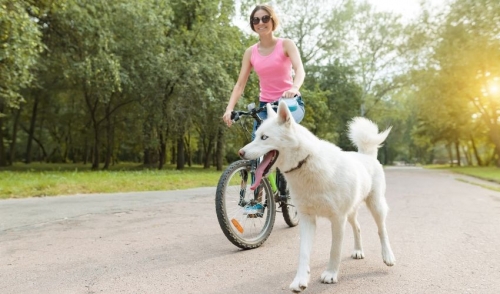
Biking with Your Dog
We all love to walk with our dogs. It is a great way to get exercise and to bond with your pet. However, some of us live in places where dogs cannot always get the exercise they need due to city living or small backyards. There are also many dogs that need more intense exercise than they can get just by walking. For most of us, running for a couple of miles with the dog is out of the question. The solution - consider biking with your dog. This way of spending time with your dog is becoming more and more popular. For those who wish to engage in this activity, it can be done safely. Before you start there are some things to consider, such as proper training, and planning.
1. Understand your pet’s abilities and limitations: Not all dogs are suited to biking with their owners. Older or arthritic dogs, ones with short legs or short noses or breathing issues are poor candidates for such activity. In fact, dogs less than 25 pounds are not usually good candidates at all. Dogs that are grossly overweight or out of shape should begin with a weight loss program and a gradually increasing walking regiment before any biking activity.
2. Don't forget the "running shoes": Some dogs have naturally sensitive pads or get sore pads from running on a hard surface. Consider using a conditioning wax on their pads or using booties. If using booties, remember it may take some time for your dog to become accustomed to them. Also, be sure to use a bootie with a tough bottom so it will stand up to heavy use.
3. Water and snacks: When your dog is running alongside the bike, he is working just as hard or harder than you. Be sure to carry extra water and a collapsible water bowl so he can stay hydrated along the way. For longer excursions, take along some snacks as well.
4. Equipment: If you're going to bike with your dog, there is a piece of equipment that will be necessary. It is a dog walking device that attaches to the bike and to your dog. Riding with a leash in one hand or attached to your handlebars or seat is unsafe. If your dog gets scared or distracted suddenly, he can pull you off balance and both of you can be injured. These walking devices (Springer, WalkingDog, and BikerDog) allow you to keep both hands on the handlebars, your dog at a safe distance from the bike, and uses a spring loaded mechanism to buffer sudden changes in movement. You should also attach your dog to the bike using a harness rather than a collar to protect his neck.
5. Training: In real estate, it is all about location, location, location. When biking with your dog it is all about training, training, training. There is a learning curve for your dog just as there was when you were learning to ride a bike. Take the time needed to get your dog accustomed to being around a bike. Call him over to the bike and reward him with treats and praise. Try moving the bike into different stationary positions, as well. Once accustomed to being around the bike, move to the outdoors and slowly start walking with the bike and your dog. Continue using treats and praise for rewards. When comfortable, trade in the leash for the bike attachment device and continue walking with increasing speed. Slowly get onto the bike and start riding, working up to longer and longer distances. Continue rewarding with treats and praise. Remember, always let your dog set the pace. Your dog should also be taught the words stop, slow, easy, turn, right and left to help signal to him of your intensions.
6. Where to ride? Busy roads and highways can be dangerous. While some of them may have a wide shoulder, biking with your dog will actually triple your riding width. Also, the noise of a busy highway or being honked at by cars may scare your dog. Consider biking in a more rural area or a less traveled road or a dirt road. Old rail road tracks that have been converted to biking or walking trails are ideal because they are flat, scenic and quiet. Many parks have paved running trails. Mountain biking trails are not appropriate for dogs of any breed or athletic ability. The sudden stopping, starting, and rapid direction changes necessary on these trails do not make this a safe activity for you and your dog.
7. General Guidelines: For most dogs, 2-3 miles is a good goal to work up to. Some athletic dogs with training and time may be able to go longer distances. When you stop for a break if it takes more than 10 minutes for your dog to stop panting, then you need to shorten the distance until he is in better condition. Spring and fall are the best times to bike with your dog. It is too hot in the summer months to do this activity safely.
8. The non-athlete or the cat: For toy breeds, handicapped or older dogs, and some cats, consider sharing the outdoors by biking with a basket, a cart, or a sidecar. Remember to introduce this activity slowly and stop at any point if they seem nervous or distressed. Passenger pets should always be secured with a harness.
By using these simple steps and safety tips, biking outdoors with your pet can be fun and rewarding for all.
The feed room is proudly brought to you by Nutrena and Cargill Animal Nutrition. Learn more about us here. You can see the original blog post here.
